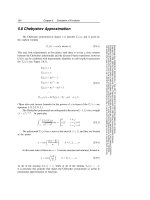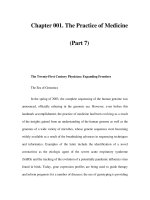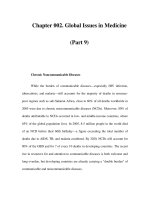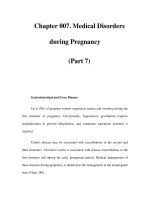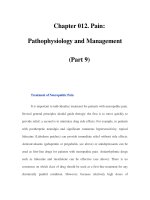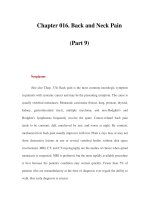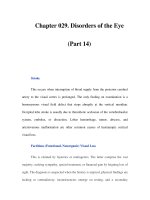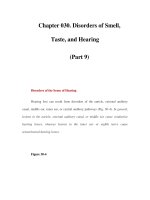Chapter 099. Disorders of Hemoglobin (Part 9) docx
Bạn đang xem bản rút gọn của tài liệu. Xem và tải ngay bản đầy đủ của tài liệu tại đây (52.97 KB, 5 trang )
Chapter 099. Disorders of
Hemoglobin
(Part 9)
Unstable hemoglobins occur sporadically, often by spontaneous new
mutations. Heterozygotes are often symptomatic because a significant Heinz body
burden can develop even when the unstable variant accounts for a portion of the
total hemoglobin. Symptomatic unstable hemoglobins tend to be β-globin variants,
because sporadic mutations affecting only one of the four α-globins would
generate only 20–30% abnormal hemoglobin.
Hemoglobins with Altered Oxygen Affinity
High-affinity hemoglobins [e.g., Hb Yakima (β
99Asp -> His
)] bind oxygen
more readily but deliver less O
2
to tissues at normal capillary P
O2
levels (Fig. 99-
2). Mild tissue hypoxia ensues, stimulating RBC production and erythrocytosis
(Table 99-3). In extreme cases, the hematocrits can rise to 60–65%, increasing
blood viscosity and producing typical symptoms (headache, somnolence, or
dizziness). Phlebotomy may be required. Typical mutations alter interactions
within the heme pocket or disrupt the Bohr effect or salt-bond site. Mutations that
impair the interaction of HbA with 2,3-BPG can increase O
2
affinity because 2,3-
BPG binding lowers O
2
affinity.
Low-affinity hemoglobins [e.g., Hb Kansas (β
102Asn -> Lys
)] bind sufficient
oxygen in the lungs, despite their lower oxygen affinity, to achieve nearly full
saturation. At capillary oxygen tensions, they lose sufficient amounts of oxygen to
maintain homeostasis at a low hematocrit (Fig. 99-2) (pseudoanemia). Capillary
hemoglobin desaturation can also be sufficient to produce clinically apparent
cyanosis. Despite these findings, patients usually require no specific treatment.
Methemoglobinemias
Methemoglobin is generated by oxidation of the heme iron moieties to the
ferric state, causing a characteristic bluish-brown muddy color resembling
cyanosis. Methemoglobin has such high oxygen affinity that virtually no oxygen is
delivered. Levels >50–60% are often fatal.
Congenital methemoglobinemia arises from globin mutations that stabilize
iron in the ferric state [e.g., HbM Iwata (α
87His -> Tyr
), Table 99-3] or from
mutations that impair the enzymes that reduce methemoglobin to hemoglobin
(e.g., methemoglobin reductase, NADP diaphorase). Acquired
methemoglobinemia is caused by toxins that oxidize heme iron, notably nitrate
and nitrite-containing compounds.
Diagnosis and Management of Patients with Unstable Hemoglobins,
High-Affinity Hemoglobins, and Methemoglobinemia
Unstable hemoglobin variants should be suspected in patients with
nonimmune hemolytic anemia, jaundice, splenomegaly, or premature biliary tract
disease. Severe hemolysis usually presents during infancy as neonatal jaundice or
anemia. Milder cases may present in adult life with anemia or only as unexplained
reticulocytosis, hepatosplenomegaly, premature biliary tract disease, or leg ulcers.
Because spontaneous mutation is common, family history of anemia may be
absent. The peripheral blood smear often shows anisocytosis, abundant cells with
punctate inclusions, and irregular shapes (i.e., poikilocytosis).
The two best tests for diagnosing unstable hemoglobins are the Heinz body
preparation and the isopropanol or heat stability test. Many unstable Hb variants
are electrophoretically silent. A normal electrophoresis does not rule out the
diagnosis.
Severely affected patients may require transfusion support for the first 3
years of life, because splenectomy before age 3 is associated with a significantly
higher immune deficit. Splenectomy is usually effective thereafter, but occasional
patients may require lifelong transfusion support. Even after splenectomy, patients
can develop cholelithiasis and leg ulcers. Splenectomy can also be considered in
patients exhibiting severe secondary complications of chronic hemolysis, even if
anemia is absent. Precipitation of unstable hemoglobins is aggravated by oxidative
stress, e.g., infection, antimalarial drugs.
High-O
2
affinity hemoglobin variants should be suspected in patients with
erythrocytosis. The best test for confirmation is measurement of the P
50
. A high-O
2
affinity Hb causes a significant left shift (i.e., lower numeric value of the P
50
);
confounding conditions, e.g., tobacco smoking or carbon monoxide exposure, can
also lower the P
50
.
High-affinity hemoglobins are often asymptomatic; rubor or plethora may
be telltale signs. When the hematocrit reaches to 55–60%, symptoms of high blood
viscosity and sluggish flow (headache, lethargy, dizziness, etc.) may be present.
These persons may benefit from judicious phlebotomy. Erythrocytosis represents
an appropriate attempt to compensate for the impaired oxygen delivery by the
abnormal variant. Overzealous phlebotomy may stimulate increased erythropoiesis
or aggravate symptoms by thwarting this compensatory mechanism. The guiding
principle of phlebotomy should be to improve oxygen delivery by reducing blood
viscosity and increasing blood flow rather than restoration of a normal hematocrit.
Modest iron deficiency may aid in control.
